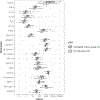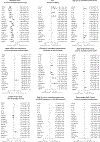Coordination of inflammatory responses in children with perinatally acquired HIV infection
- PMID: 35442223
- PMCID: PMC9262767
- DOI: 10.1097/QAD.0000000000003229
Coordination of inflammatory responses in children with perinatally acquired HIV infection
Abstract
Objective: We investigated dynamics of inflammatory biomarkers in children with perinatally acquired HIV (PHIV) who started antiretrovirals at age less than 3 years and achieved sustained virologic control (HIV plasma RNA <400 copies/ml).
Design: This was a retrospective analysis of inflammatory biomarkers in children enrolled in a randomized trial of early (<3 years of age) PI-based versus NNRTI-based regimens (P1060), who achieved sustained virologic control and participated in a neurodevelopmental follow-up study (P1104s) between ages 5 and 11 years.
Methods: We measured 20 inflammatory biomarkers using ELISA or chemiluminescence at onset of sustained virologic control (Tc) and at P1104s entry (Te).
Results: The 213 participants had median ages of 1.2, 1.9, and 7 years at antiretroviral initiation, Tc, and Te, respectively, with 138 on protease inhibitor-based and 74 on NNRTI-based regimens at Tc. Eighteen markers decreased and two increased from Tc to Te (Te-Tc). Biomarker subsets, particularly cytokines, the chemokine IP-10, and adhesion molecules sICAM-1 and sVCAM-1, correlated at Tc, Te, and Te-Tc. At Tc, higher biomarker levels were associated with younger age, female sex, HIV plasma RNA at least 750 000 copies/ml, lower nadir CD4 + %, lower nadir weight z scores, and NNRTI-based treatment. Greater Te-Tc biomarker declines were associated with younger age, male sex, higher Tc biomarker levels, lower nadir CD4 + %, and NNRTI-based treatment. Duration of controlled viremia and nadir height z scores showed mixed associations.
Conclusion: Biomarker expression showed substantial coordination. Most markers decreased after virologic control. Demographic and clinical variables associated with biomarker patterns were identified. Mechanistic studies of these biomarker patterns are needed to inform interventions to control inflammation.
Copyright © 2022 Wolters Kluwer Health, Inc. All rights reserved.
Conflict of interest statement
Conflict of Interest
AW receives research grants from NIH, GSK, Merck and Janssen, and personal fees from Merck and Seqirus. Other authors do not have anything to declare.
Figures




References
-
- Letizia A, Eller MA, Polyak C, Eller LA, Creegan M, Dawson P, et al. Biomarkers of Inflammation Correlate With Clinical Scoring Indices in Human Immunodeficiency Virus-Infected Kenyans. J Infect Dis 2019; 219(2):284–294. - PubMed
Publication types
MeSH terms
Substances
Grants and funding
LinkOut - more resources
Full Text Sources
Medical
Research Materials
Miscellaneous

